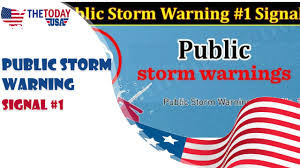Lead Time Signs and Impact of Public Storm Warning Signal #1

If you are planning for a hurricane, storm, or other tropical cyclone, you might be wondering about the impact of a public storm warning signal (TCWS). A TCWS is a warning signal issued 36 hours ahead of a tropical cyclone to warn the public about its intensity and potential impacts. This signal also indicates which areas will be impacted by the storm.
TCWS
A Public Storm Warning Signal is an early warning of an impending storm that’s predicted to be widespread and potentially damaging. The warning signal contains a graphic that displays wind speed, power, and precipitation. This tool can help you prepare for storms and is a vital part of Meteorology Department safety plans.
TCWS lead times depend on a number of factors. The strength of the tropical cyclone, its size, and its direction can all have a large impact on the lead time. Typically, a primary stage signal will be issued a day and a half before the expected meteorological conditions manifest. By the time the storm is expected to be closer to land, the lead time may be even shorter.
A public storm warning signal indicates that a tropical cyclone is imminent and will cause strong winds and light to moderate damage. However, it does not mean that the conditions will be felt in the area. The warning signal is ranked according to the Pagasa scale, with the lowest number indicating minimal risk and the highest warning signal, TCWS Number five, which indicates moderate to severe danger.
A public storm warning signal is issued when a tropical cyclone is expected to make landfall within 36 hours. Residents can use this warning to determine whether they will need to evacuate or seek shelter in a safer location. The warning signal also informs residents of the storm’s wind speed and intensity. It also gives them a chance to prepare by staying home and taking long-term shelter in the event they need to evacuate.
TCWS signals are issued 36 hours before a tropical cyclone
The TCWS system provides a warning of the general strength of the winds associated with a tropical cyclone. The warning indicates how much wind is expected to affect a locality in the next 36 hours. Winds are generally stronger over high ground and offshore water, while they are weaker in sheltered areas.
When a tropical cyclone warning signal is issued, it means that it is likely to cause light to moderate damage to structures and vegetation. People in low-lying areas should evacuate to higher ground. Those traveling by sea or air should stay home.
When a TCWS is issued, it is important to follow the warning. The warnings will give you a detailed description of the storm and the risks associated with it. It will also include any advice for the general public and fishermen in the area.
When a TCWS signal is issued, it means that a tropical cyclone is predicted to reach a tropical storm force within 36 hours. It can bring storm surge, coastal flooding, and damaging winds. When a TCWS signal is issued in advance, people should begin preparing for the storm and reviewing their evacuation plans.
A TCWS signal will also impact flights and ferries. During a typhoon warning, flights may be cancelled, and ferries may be disrupted.
TCWS signals indicate the intensity
Public storm warning signals are visual storm warning signs hoisted on masts in port areas. These signals are red and white in color. They indicate the intensity of tropical cyclones. They are based on WMO tropical cyclone categories. These warnings are intended to warn mariners of severe storms.
Public storm warning signal #1 means a tropical cyclone is moving toward the location and will affect the region. The storm may bring wind gusts of 30 – 60 kph, and rains for the next 36 hours. The shorter lead time indicates that a tropical cyclone may develop closer to a location. If the storm is moving near a location, it will be more intense and may cause more damage.
While the impacts of tropical cyclones are usually light to moderate, they may cause considerable damage to coastal communities. In extreme cases, the wind can knock down small trees and even break them. When a TCWS signal is issued, it is best to postpone outdoor activities until the storm has passed.
Public storm warning signals indicate the intensity of a tropical cyclone. They also show the path of a storm. This is important for people in the area.
TCWS signals indicate the areas that will be affected
When a PSWS is issued, it means that severe weather is expected in the area within the next 36 hours. This warning is important because the storm is likely to be devastating to property, and wind gusts of 120 kph or higher are possible. If you’re in the area, you should take the time to prepare for the storm, and if possible, evacuate as soon as possible.
The lead time for a PSWS is 36 hours when issued, and this time period decreases as the storm gets closer. This lead time is not a reliable indicator of how long the storm will last. If a storm is not predicted to last for 36 hours, the TCWS signal will be reissued at a higher level. This way, the public will have ample time to prepare.
The TCWS system has two main purposes: to warn of upcoming weather disturbances, and to keep people safe. The first is to alert people to the potential dangers of a tropical cyclone. The second is to provide information on the severity of a tropical cyclone’s winds. The new system was put into place on March 23, 2022, which was the 157th/72nd World Meteorological Day.
In addition to warning residents about potential hazards, TCWS signals also alert emergency managers about risks and resources. It’s important to evaluate the risks and decide how much money to spend on emergency planning. This will include internal resources and external resources such as local law enforcement and public emergency services. It’s also important to plan for multiple scenarios and take different threats into account.
TCWS signals guide emergency management
The TCWS signals are a system of warnings for tropical cyclones. Each signal gives lead time, or the number of hours that a tropical cyclone will have before it makes landfall. Higher lead times indicate stronger winds, while lower ones indicate weaker winds. A tropical cyclone warning signal is issued for the first time about 36 hours before the threat of the storm arrives, giving the public plenty of time to prepare and evacuate.
When a PSWS signal is issued, organizations should begin to prepare for the onset of a storm. These signals provide important information about the storm’s size, direction, and wind speed. In addition to providing information about the storm’s severity, they also guide emergency management. Those who manage emergency operations should have a comprehensive plan in place to prepare for all potential threats.
The TCWS system uses five levels to indicate wind strength. High signal numbers indicate strong winds with impact on local areas. High signals also provide a shorter lead time than lower ones, which allows people to take precautionary measures in advance. However, the warnings are valid for only a limited time.
Tropical cyclone warnings and watches are issued by the Philippine Atmospheric, Geophysical, and Astronomical Services Administration. These are issued twice daily, and are issued only when a tropical cyclone is expected to make landfall within 24 hours. TCWS signals are often issued twice a day, which means that they are not issued all the time.
TCWS signals have saved lives
The TCWS system is crucial in warning people about the upcoming arrival of a tropical cyclone. Signals indicate the expected wind speed and direction. TCWS signals are issued at city and municipal levels as well as at the provincial level. For instance, one TCWS signal indicates that the wind speed is likely to reach 39 km/h or less for the next 36 hours. The lead time is used to help local communities understand how much time they still have before the cyclone arrives.
In addition to warning people about the upcoming cyclone, the TCWS system provides information about the associated risks to sea and land. Although TCWS does not provide information about rainfall, other weather warning systems are in place to alert people about heavy and prolonged rain. In such cases, a warning may help save lives and avoid further damage.
TCWS signals have been crucial in saving lives during several storms, including cyclone Sidr and tropical storm Mahasen in Bangladesh. TCWS signals have also proved useful in the commercial sector, where the Norwegian Hull Club and other shipping companies use the TCWS signals to steer their vessels away from hazardous storms. In addition, the real-time warnings have been used by humanitarian organizations and government agencies in Bangladesh to avoid a disaster or life-threatening situation.








